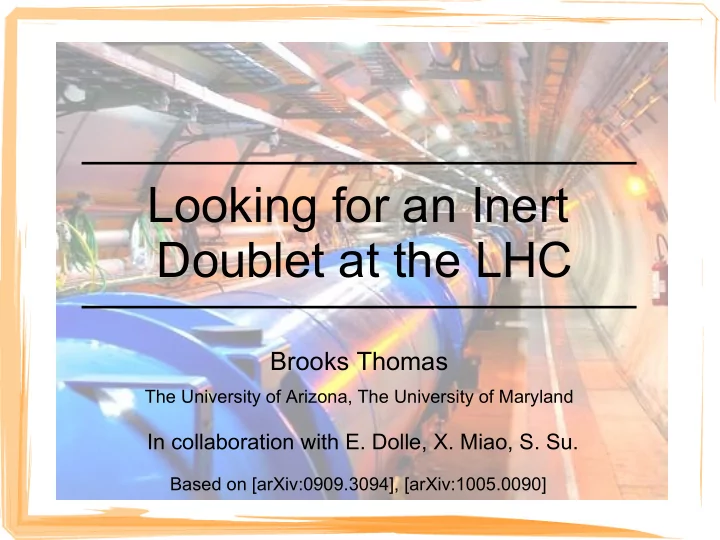

Looking for an Inert Doublet at the LHC Brooks Thomas The University of Arizona, The University of Maryland In collaboration with E. Dolle, X. Miao, S. Su. Based on [arXiv:0909.3094], [arXiv:1005.0090]
Since this is the last talk in this session, many of you are now thinking about warm dark matter... ...so if you're interested in more details, please don't hesitate to ask me during the coffee break.
What is an Inert Doublet? It's a scalar SU(2) doublet that receives no VEV and has no Yukawa couplings with SM fermions. Even Odd (Note that this is not your typical 2HDM.)
Why would one want an Inert Doublet? Such doublets have a host of phenomenological applications: A promising dark matter candidate: the “LIP” A promising dark matter candidate: the “LIP” ● Oblique S and T Contributions from an inert Oblique S and T Contributions from an inert ● doublet allow for a heavy (400-600 GeV) Higgs. doublet allow for a heavy (400-600 GeV) Higgs. A connection to neutrino physics A connection to neutrino physics ● Triggering Electroweak symmetry-breaking Triggering Electroweak symmetry-breaking ● Plus a wide variety of theoretically-motivated models include inert doublets, or reduce to the SM + Extra Scalar doublets at low energies (e.g. LR Twin Higgs).
Parameter Space of the Model Parameter Space of the Model Physical Scalars Mass Splittings: Take S to be the LIP: Also useful to define:
Constraints on the IDM Consistency Conditions Consistency Conditions ● Vacuum Stablility ● Perturbativity Experimental Constraints Experimental Constraints ● Dark matter relic abundance (WMAP) ● Precision electroweak constraints (LEP) ● BSM Searches (LEP) ● Direct detection bounds (CDMS, etc.)
Combined Constraints: Light Higgs Light LIP: Very light LIP: Direct detection limits LEP direct searches m s ~ 60 - 80 GeV m s ~ 40 GeV Vacuum stability Perturbativity DM relic density
Combined Constraints: Heavy Higgs PEW constraints imply heavy charged scalars LIP Mass ~ 75 - 80 GeV Direct detection limits LEP direct searches Vacuum stability Perturbativity DM relic density
Detection Prospects at LHC There are many ways in which one may detect the presence of an additional, inert doublet at the LHC. These include: Dilepton Channel: 1 (Initial discovery process at LHC) Trilepton Channel: 2 (Additional evidence for IDM, further information about the scalar mass spectrum)
Benchmark Scenarios for Collider Phenomenology Benchmark Scenarios for Collider Phenomenology Satisfy all applicable constraints and reproduce the WMAP DM abundance within 3 σ range. Light Higgs Heavy Higgs
Benchmark Scenarios for Collider Phenomenology Benchmark Scenarios for Collider Phenomenology Satisfy all applicable constraints and reproduce the WMAP DM abundance within 3 σ range. Light Higgs Heavy Higgs
Benchmark Scenarios for Collider Phenomenology Benchmark Scenarios for Collider Phenomenology Satisfy all applicable constraints and reproduce the WMAP DM abundance within 3 σ range. Light Higgs Heavy Higgs
Benchmark Scenarios for Collider Phenomenology Benchmark Scenarios for Collider Phenomenology Satisfy all applicable constraints and reproduce the WMAP DM abundance within 3 σ range. Light Higgs Heavy Higgs
Benchmark Scenarios for Collider Phenomenology Benchmark Scenarios for Collider Phenomenology Satisfy all applicable constraints and reproduce the WMAP DM abundance within 3 σ range. Light Higgs Heavy Higgs
Dilepton Channel: Signals Signal Process Model-Dependent Backgrounds
Standard-Model Backgrounds
Event Selection Event Selection Level I: Detector Acceptance Cuts Level I: Detector Acceptance Cuts Hard Jets Level II: Universal Background Level II: Universal Background Suppression Cuts Suppression Cuts
Event Selection Event Selection Level III: Optimization Cuts Level III: Optimization Cuts Nearly back-to-back
Invariant Mass Distributions LH1 LH3 Note: all distributions Normalized to one!
Charged-Lepton Separation LH3 LH3 Off shell: On shell:
Best Discovery Prospects: Best Discovery Prospects: Results Light Higgs (LIP accounts for DM relic abundance) Dramatic signal! Heavy Higgs (DM relic abundance and improved naturalness!)
Light Scalars, On-Shell Decay: Light Scalars, On-Shell Decay: Results Light Higgs (LIP accounts for DM relic abundance) Heavy Higgs (DM relic abundance and improved naturalness!)
Heavier Scalars, Off-Shell Decay: Heavier Scalars, Off-Shell Decay: Results Light Higgs (LIP accounts for DM relic abundance) Heavy Higgs (DM relic abundance and improved naturalness!)
… and from this, we learn: and from this, we learn: … The best prospects for detection in the dilepton channel are ob- tained for a light Higgs boson (m h ~ 114 – 180 GeV) and: with a statistical significance as high as ~ 10 σ . … but also (and perhaps even more importantly): but also (and perhaps even more importantly): … It is possible for the IDM to explain the observed dark-matter abundance, provide the necessary S and T contributions to correct for a heavy Higgs, and at the same time yield visible signals in the dilepton channel at the LHC!
Analysis: Trilepton Channel The Most Relevant Processes: a b
Event Selection Event Selection Level I + II Level I + II Level III Level III (Soft)
Trilepton Channel Results Trilepton Channel Results [arXiv:1005.0090] 5 σ discovery in both dilepton & trilepton channels!
Summary and Conclusions
Extra Slides
LIP Dark Matter LIP Dark Matter WMAP-Allowed Region
LIP Dark Matter LIP Dark Matter WMAP-Allowed Region
LIP Dark Matter LIP Dark Matter WMAP-Allowed Region And things may even be a little bit better...
Problems with Soft Leptons LH1 LH3
Recommend
More recommend